Sorry Wimms,
I read your post as saying the only way a flat response speaker could sound bad is if you used brute force to make it flat.
m0tion,
I don't think it's only distortion, although I'm sure it's a big factor. Different speakers sound different. Some I like and some I don't. Take 2 drivers that are both ruler flat in response over a specific range, but they don't sound identical. Is the sonic difference only distortion? Or is it something purely subjective?
I read your post as saying the only way a flat response speaker could sound bad is if you used brute force to make it flat.
m0tion,
I don't think it's only distortion, although I'm sure it's a big factor. Different speakers sound different. Some I like and some I don't. Take 2 drivers that are both ruler flat in response over a specific range, but they don't sound identical. Is the sonic difference only distortion? Or is it something purely subjective?
The measurements are done with slow sweep of pure sinewave.
Very rarely. The use of FFT/MLS is almost universal.
The point that's been brought up and then seemingly walked past is that the frequency response of a speaker is NOT a single measurement except in the special case of a true omnidirectional speaker. As soon as you say "flat frequency response," the question is "measured where?" If a speaker is flat at some point A, it won't be at another point B. Those tradeoffs are why speakers have to be designed.
Another listen, this time to Patti
Hopefully, I'll get another listen in the near future. The owner isn't my friend, just an acquaintance. And if he reads this forum he certainly won't be either. But if I can, I want to take the best sounding CD I own and hear it on his system. That would be Patti Scialfa's "Rumble Doll."
Hopefully, I'll get another listen in the near future. The owner isn't my friend, just an acquaintance. And if he reads this forum he certainly won't be either. But if I can, I want to take the best sounding CD I own and hear it on his system. That would be Patti Scialfa's "Rumble Doll."
SY said:As soon as you say "flat frequency response," the question is "measured where?"
I'm satisfied with this thesis.
why is everyone striving for flat freqquency responses, since that isn't how our hearing works?
Thats right, go buy a set of printing machines and have fun listening diferent apealing printing noises combinations.
Good Night
Goss
I think a fair number of of 'in your face' mic'ed recordings would risk being strident played back on a really flat system. Who would stand immediately in front of a brass section when trying to hear a big band, anyway? And most speakers and amps will harsh up strong high frequency content material played back at live levels IAC even if it weren't already trashed out by lousy recording or CD mastering, making it much less pleasant. There's also the factor that the very nature of a stereo speaker setup will emphasize the highs of centered information by a few db due to differences in the incident angle to the ears and head diffraction compared to the live sound source directly in front of a listener that it is attempting to reproduce.
The power response flatness of the speaker and its interaction with the room will also affect the perception of brightness. A speaker with a beamy HF equalized for flat sine wave response at the listening position will tend to sound excessively bright on transients.
The power response flatness of the speaker and its interaction with the room will also affect the perception of brightness. A speaker with a beamy HF equalized for flat sine wave response at the listening position will tend to sound excessively bright on transients.
The subjective impression of a speaker's tonal balance is determined by the total amount of acoustic energy reaching the ear, and this includes both direct sound and sound that is reflected from the room surfaces (walls, ceiling and floor) and furnishings (coffee tables, TVs etc.). When a speaker designer tailors the tonal balance of a speaker, he needs to consider both on-axis response (direct sound) and off-axis response (reflected sound).
FWIW, it is possible to make a speaker which has damn-near flat response on-axis without having it sound bright. The key is to make the response fall smoothly off-axis, so there is less energy coming back at you from the wall.
One of our listening systems uses such a speaker and we listen very close (from a distance of 100~160cm). It is revealing in a similar manner as a pair of electrostatic headphones (it is supposed to, as we developed it as a monitor speaker), but it isn't bright. I've heard many brighter-sounding speakers that, when measured, actually have a more falling on-axis response in the treble range.
hth, jonathan carr
FWIW, it is possible to make a speaker which has damn-near flat response on-axis without having it sound bright. The key is to make the response fall smoothly off-axis, so there is less energy coming back at you from the wall.
One of our listening systems uses such a speaker and we listen very close (from a distance of 100~160cm). It is revealing in a similar manner as a pair of electrostatic headphones (it is supposed to, as we developed it as a monitor speaker), but it isn't bright. I've heard many brighter-sounding speakers that, when measured, actually have a more falling on-axis response in the treble range.
hth, jonathan carr
My latest speakers sound bright when adjusted to give a flat frequency response. It could be that I'm not used to listening to speakers with a flat response. I listen to the TV more often, and that is just one small speaker, no tweeter, so to hear a full range system is a surprise. The extended bass is a very welcome change, but the extended treble perhaps takes some getting used to.
In Hi-Fi World's DIY projects, they balanced the frequency response of their speaker designs so that the treble response is gently rolled off. They said that a flat treble response sounds too bright.
In Hi-Fi World's DIY projects, they balanced the frequency response of their speaker designs so that the treble response is gently rolled off. They said that a flat treble response sounds too bright.
johnnyx said:My latest speakers sound bright when adjusted to give a flat frequency response. It could be that I'm not used to listening to speakers with a flat response. I listen to the TV more often, and that is just one small speaker, no tweeter, so to hear a full range system is a surprise. The extended bass is a very welcome change, but the extended treble perhaps takes some getting used to.
In Hi-Fi World's DIY projects, they balanced the frequency response of their speaker designs so that the treble response is gently rolled off. They said that a flat treble response sounds too bright.
Most likely distortion and/or lack of baffle step correction. Strong early reflections from hard surfaces may contribute as well. Flat in itself does not make for bright or harsh by any means on most material.
/Peter
In my experience it only takes a 2db raise in the treble/midrange to push the difference between 'bright' and 'normal'....
I'm guessing the original poster's problems are with either distortion or room modes though
fwiw : my speaks are pretty much flat from 15Hz to 25kHz...
Isn't there a recommended roll off at the top end for theater / cinema applications ? - maybe this would work for jmikes tastes.
Cheers,
Rob
btw johnnyx, if the speakers that hifi world made were rolling off early then the mid/tweets would be accentuated purely by the lack of bass to balance them. ie: no low bass, roll off the mid/tweet to stop them sounding 'bright'... if that makes sense..
my old b+w 602's sounded 'hard' but when I added a sub they 'warmed up' as the lower bass stuff balanced out the treble/mids.
Cheers,
Rob
I'm guessing the original poster's problems are with either distortion or room modes though
fwiw : my speaks are pretty much flat from 15Hz to 25kHz...
Isn't there a recommended roll off at the top end for theater / cinema applications ? - maybe this would work for jmikes tastes.
Cheers,
Rob
btw johnnyx, if the speakers that hifi world made were rolling off early then the mid/tweets would be accentuated purely by the lack of bass to balance them. ie: no low bass, roll off the mid/tweet to stop them sounding 'bright'... if that makes sense..
my old b+w 602's sounded 'hard' but when I added a sub they 'warmed up' as the lower bass stuff balanced out the treble/mids.
Cheers,
Rob
A summary of some research presented at the most recent AES convention might be interesting here (quoted from a summary by Earl Geddes' without permission):
Next was a very important paper by Sean Olive at JBL. He showed that in a statistically significant double blind test of a large number of listeners (not all JBL employees) that he could predict, from measurements, what the groups opinion of a loudspeaker would be 99% of the time (correlation was .995 but the difference for most people is not worth worrying about.) This is somewhat reminiscent of our recent arguments on this same subject where some contend that this is not possible.
Sean did a multiple regression of some 10 or 15 different measurements against the subjective impression and found that about three measures accounted for virtually all of the variability in the subjective impression. They were direct sound smoothness (about 50% of the variance), followed by smoothness of the power response (about 30%) and finally the spectral balance - overall flatness (about 15%). Of note is the fact that distortion did not enter into the ratings at all - it is irrelevant. I like to say that "loudspeaker distortion is not a problem, however overdriving a
loudspeaker is". Get speakers with enough output so that you don't have to overdrive them and distortion is not an issue. Hence largish high efficiency speakers.
I was personally very satisfied with these results since the rankings are exactly what I would describe as the most important criteria for
loudspeakers. One can spend endless hours worrying about things that are not in the top three, like phase response, time alignment, whatever, but if you don't get these three right, only you will like the sound of your speakers (which is always guaranteed). And, Oh, by the way, as I have said so often, simple piston sources cannot have flat power responses.
End quote.
Something else that Sean mentioned in his talk was that he found that the power response of a speaker should not be flat - it should roll off at high frequencies. IOW, narrowing of the polar response as frequency increases is fine, as long as the power response remains smooth. Further, I believe he said that all this research was stimulated by some of JBL's speakers being badly ranked by consumer reports. As part of the study, the consumer reports metric was included, and it was found to have a negative correlation with subjective opinion on a loudspeaker. I believe (didn't write it down) that consumer reports goes purely off power response - Sean pointed out that their method effectively said that the speaker should sound the same pointed into the corner as it would facing you which is obviously not true.
I would also say that I disagree with Earl's sweeping generalization that distortion is not important at all as long as you don't 'overdrive' them, as almost all loudspeakers have distortion as soon as they move from rest (ie, make any sound), and from other factors, but I would say that these are the sorts of things that us audiophile nut jobs should be persuing as the last 1% in our systems or whatever (because we should all already be able to design speakers with smooth, flat on-axis amplitude response and smooth power response).
Next was a very important paper by Sean Olive at JBL. He showed that in a statistically significant double blind test of a large number of listeners (not all JBL employees) that he could predict, from measurements, what the groups opinion of a loudspeaker would be 99% of the time (correlation was .995 but the difference for most people is not worth worrying about.) This is somewhat reminiscent of our recent arguments on this same subject where some contend that this is not possible.
Sean did a multiple regression of some 10 or 15 different measurements against the subjective impression and found that about three measures accounted for virtually all of the variability in the subjective impression. They were direct sound smoothness (about 50% of the variance), followed by smoothness of the power response (about 30%) and finally the spectral balance - overall flatness (about 15%). Of note is the fact that distortion did not enter into the ratings at all - it is irrelevant. I like to say that "loudspeaker distortion is not a problem, however overdriving a
loudspeaker is". Get speakers with enough output so that you don't have to overdrive them and distortion is not an issue. Hence largish high efficiency speakers.
I was personally very satisfied with these results since the rankings are exactly what I would describe as the most important criteria for
loudspeakers. One can spend endless hours worrying about things that are not in the top three, like phase response, time alignment, whatever, but if you don't get these three right, only you will like the sound of your speakers (which is always guaranteed). And, Oh, by the way, as I have said so often, simple piston sources cannot have flat power responses.
End quote.
Something else that Sean mentioned in his talk was that he found that the power response of a speaker should not be flat - it should roll off at high frequencies. IOW, narrowing of the polar response as frequency increases is fine, as long as the power response remains smooth. Further, I believe he said that all this research was stimulated by some of JBL's speakers being badly ranked by consumer reports. As part of the study, the consumer reports metric was included, and it was found to have a negative correlation with subjective opinion on a loudspeaker. I believe (didn't write it down) that consumer reports goes purely off power response - Sean pointed out that their method effectively said that the speaker should sound the same pointed into the corner as it would facing you which is obviously not true.
I would also say that I disagree with Earl's sweeping generalization that distortion is not important at all as long as you don't 'overdrive' them, as almost all loudspeakers have distortion as soon as they move from rest (ie, make any sound), and from other factors, but I would say that these are the sorts of things that us audiophile nut jobs should be persuing as the last 1% in our systems or whatever (because we should all already be able to design speakers with smooth, flat on-axis amplitude response and smooth power response).
In my experience it only takes a 2db raise in the treble/midrange to push the difference between 'bright' and 'normal'....
That generally agrees with my experience. Wrt perceptible 'distortion', my listening experience has led me to be a fan of esoterica such as underhung vc's & the use of alnico magnets that have better BH curve linearity and less susceptibility to flux modulation from vc back emf's than ferrite (as long as they're not overpowered - something that is much less likely with underhung vc's, btw) , although JBL has partly compensated for that in their ferrite magnet offerings with shorting rings and symmetrically saturated gaps.
A couple of things up front: I'm no audiophile and I'm new to building my own speakers. With those caveats in mind, can someone answer a question that's been bugging me since I started researching DIY speaker building: why is everyone striving for flat freqquency responses, since that isn't how our hearing works?
My wonder got quite a boost last night. I was invited to hear a very expensive, highly tuned system. There were enough Sunfire amps in the room to power a large cruiseliner. The owner had built the speakers himself out of the finest components he could find. Then he spent days and days tweaking them until his response curve was remarkably flat. He even took them to a recording studio in town for testing. I was impressed with his data. Then he played them for me. They were about the worst sounding speakers I've ever heard. Harsh and shrill to an extreme. In fact, they had a treble boost that I feared was going to peel the paint from the walls, if it didn't burn the skin from my body first. I'm glad the guy liked them, but I thought they were hideous.
So I'm asking, do people really like that sound? We don't have flat hearing curves, and it seems odd to me that we would want our speakers to emit sounds that are artifically boosted. It has been a long, long time since I fooled with any audio gear, but back in the early `70s when I was first interested in sound systems, the idea was to match your speakers' response with your hearing. Can't remember the specs exactly, but that required a pretty significant dip in the midrange, as much as 8-10 db at high SPLs.
So what's the deal? After a lifetime of open exhaust race cars and rock 'n roll, I know it's not because I have good high freq hearing.
There is a lot that can be done with audio, when I were younger, I were demonstrated the most amazing pair of speakers I've ever heard and possibly ever will hear. It were the best sound I've ever heard, it comforted me and gave me extreme emotions and feelings torwards the music being played, the other amazing thing were it had a sweetspot everywhere and the sound would be in 3d and sound like it were going way up in the air with pin point precission. It litterally blew my mind and made me "stand up and take note" and that is not a saying, it really did shock me, even if I stood really close to the speakers with my ears, it sounded like it were in my mind and there wasn't no speakers. I guess this is what has lead me here, I were googling and saw your commet about flat frequency and the ears and I've been trying to understand how such a high end system I heard works. I believe what I heard were probably the pinnacle of hi fidelity. I believe it were playing holophonics on speakers. The whole audio is confusing but I do believe I've almost know how it were done. Many will not agree with things I will say but I believe everyone is barking up the wrong tree in design principles. I totally agree to disagree and am happy with it too. It seems that most of the people are trying to make a perfectly flat response and that is great for equipment testing, we do want to know that the speakers, amp and cd from start to finish can produce roughly the same volume through the whole 20-20,000. It's great to have a great response but just a question, how on earth can a tweeter that barely moves and inch shift as much air as a massive woofer moving quite a distance in comparison. It obviously can not but in return it can play many times more. Some cross over information I been reading seems that for doubling frequency it halves the power as in db but techically I guess it's a similar amount of power as the distance travelled becomes identicle because the tweeter is at a higher hz and shorter distance. simplified example here "bass (10 hz x 10 inches) = (treble 50hz x 2 inches).
This leads me to ask about accoustics and how are ears work. It seems like everyone is trying to perfect audio and want a fantastic musical experience. That system I heard had an eq setting with bass high, the mid low and trebble high and to me and remember someone else set this up, it sounded 100% perfect to my hearing, I fell instantly in love. After hearing this system and what is possible, my brain went into thought mode, how on earth is that possible. I've spent many hours on the internet reading conflicting information and finding it hard to figure things out. I started to wonder how we hear direction, I hear people saying volume, que's etc but please put one finger in your left ear and close your eyes and get someone to click their fingers around your head, you can tell direction of sound from above below behind, yet the sound is identicle from source, so what is changing ? Remember we only have two ear drums and they can give direction from a single ear, It becomes apparent, its possible that the ear/head/accoustics are creating its own accoustical sound to the waves, depending on where the source is. The ears are biased and so it frequency biased if you compair them against each other. If I were to play a single wave at 20 hz and one at 20,000hz, there is a lot of positions in which that 20,000 hz could fit in the wave of a 20 hz, it could be at the start of the wave or a 1000 positions between or even at the end, also if interfering waves were introduced it would alter the way the waves arrive at the ear which will change the frequency order on arrival as the ear is using it's own accoustics to determine direction. If something is a closer or further distance, this would also change the waves at the ears, high frequency waves lose energy more than low but there is many of them and low is very few, so imagine a radar or lets look at a virtual reality htc Vive and the lighthouses, the timing in ms determine the location and depending how it hits the sensors gives the orientation. Are ears are definitely biased for directional purposes, this is my solid belief. If you take a break and try reading up on holophonics and about interference patterns. There is claims of the ears being like an interferometer. Lets face it we reconise a sound by its own pattern but with interference destroying all the que's, it doesn't look good in many people's eyes, I hear people talking about placing speakers particular distances from walls, sound travels at 736mph aprox, it is hitting walls and coming back to the listener, we hear direct then reflected, why does the placement mater, I believe that the reflected and direct between different hz are coming together, it creates a different frequency at the ear and when the distance is right, it creates an accoustic pattern which is equal frequencys telling our ears it's at the same distance(location). I hear people saying on most forums that interference is a problem but what if we were to replicate the same interference pattern by playing it on a different level so that they come together to create the same pattern but at a different frequency. I admit I not great at explaining but I feel playing flat is playing back the sound in 2 dimentions with one sweetspot in the focus. What we really need is to play it back for 3dimentions and set it to how we hear. So we need to create a reconisible pattern, so the ears can reconise distance/direction. Each frequency has a different lengh, some finnish much sooner, so if we were to play the start position on the same level the finnish position would be way different, so we need to compensate, so each frequency is played at a different position in order to arrive exactly as the other one finnishes but the problem is at different angles this would change but if the frequencys are arriving and interfering at the right times, the interference can change the first frequency to a new then correct the frequency accoustically by making the new frequency again with interference but will create the original frequency between the 2 new frequencys and they will both be on identical volumes. If you move location, our ears will pick up both frequencys altering at the same rate due to way they appear to be. As one frequency appears to get closer to another or on same volume, the other frequency's do the opposite but it's really the pattern that counts to reconise location and distance. I believe I'm talking about using phase difference to try and bring the frequencys together to make them coherent. I find it hard to explain, maybe 1/4 of a wave due to interference of another wave will leave 3/4 of another wave, so the other waves are re creating 3/4 and 1/4 from that angle/ perception of ears which is like two lots of of same frequency creating original but if you move you end up with a different set of frequeny interference which will create a different pattern but make it appear to be on the same level when they are different levels merging. The ears hear it in the order it arrives but the location it is sent from may alter the appearance of the frequency on arrival as the ears bias it. Let me simplify the whole thing totally. what is sent from the speaker is not what we hear at the ears, the frequencys will arrive different and need to be compensated so our ears hear the correct order of frequencys. I believe phase differences create a frequency between and if related correctly can compensate for the orientation of the sound. It's played twice, the fractions I spoke of earlier is between the frequency being played and the way it played compared to other frequencys, I think it's called phase linearity. The crosstalk is being used to create an interference accoustic. The way the frequencys are related matter and if your equipment isn't capable then no one can set it to your ears. Good sound is worth it. I guess people will argue about hrtf but if the frequencys are replicating the same frequency patterns, then surely they are also picking up the same. Patience and having each eq slider exactly right is needed to create the closet to perfect illusion. I also believe the speakers layout can also help the ears to create the patterns using array. interference is not the problem, recreating interference correctly at the right times is the problem. If the perspective is played correctly then it should return the same as the pattern is diminshing at the same rate as it gets absorbed. I expect the wave shapes are not perfect on what I heard but it were reconised by my brain and sounded perfect in every way. I guess with equipment so good, it's then down to the recording to be done properly. Flat playback sounds garbage, remember flat at the speakers or flat at the ears. I choose the ears all ways. Thanks if you read this far. Let me know if you understand or not or have an idea of what I mean. The frequencys are the actual distance and angle of the sound. Part bass from one angle, part treble from another and vica verca from a different location, the crosstalk results in correct frequency pattern at ear. Thanks.
: why is everyone striving for flat freqquency responses, .
because it is something we can measure
Maslow's hammer principle: "When the only tool you have is a hammer, all problems begin to resemble nails"
that's all
Flat frequency response is measured at a particular point on the rooms' speaker axis. It doesn't tell the whole story IMO.
Somebody once asked me to name a fullrange driver that could do it all. It's actually easy to find an example. Your average headphone driver is a 19mm. plastic tweeter that satisfies you at bass level. This is because a headphone applies a 1:1 ratio on dispersion to your eardrum.
Things are much harder in a room. Dispersion falls off as inverse square. So you need much bigger woofers than tweeters. Hence your 2 way typical big woofer and tiny tweeter. It's a question of spherical waves falling off as inverse square.
Here's a modelled speaker that looks quite awful on frequency response.
But push that close to a wall for improved bass, and it all pans out nicely. Great impedance that any cheap feedback amplifier will enjoy. And good power response left and right. Some practical speaker designs follow.
Somebody once asked me to name a fullrange driver that could do it all. It's actually easy to find an example. Your average headphone driver is a 19mm. plastic tweeter that satisfies you at bass level. This is because a headphone applies a 1:1 ratio on dispersion to your eardrum.
Things are much harder in a room. Dispersion falls off as inverse square. So you need much bigger woofers than tweeters. Hence your 2 way typical big woofer and tiny tweeter. It's a question of spherical waves falling off as inverse square.
Here's a modelled speaker that looks quite awful on frequency response.
But push that close to a wall for improved bass, and it all pans out nicely. Great impedance that any cheap feedback amplifier will enjoy. And good power response left and right. Some practical speaker designs follow.
Attachments
-
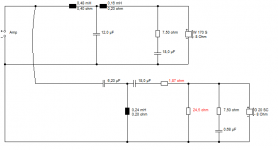 BW3 Theoretical Values.PNG8.1 KB · Views: 233
BW3 Theoretical Values.PNG8.1 KB · Views: 233 -
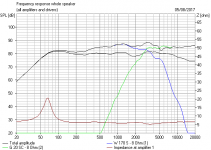 BW3 speaker.PNG21.9 KB · Views: 235
BW3 speaker.PNG21.9 KB · Views: 235 -
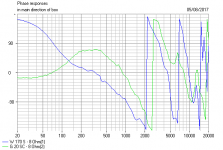 BW3 Phase Response.PNG24.9 KB · Views: 234
BW3 Phase Response.PNG24.9 KB · Views: 234 -
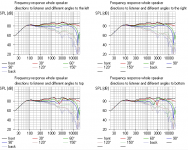 BW3 Power response.PNG26.7 KB · Views: 236
BW3 Power response.PNG26.7 KB · Views: 236 -
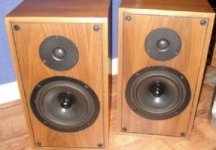 Heybrook HB2 speaker.JPG19.1 KB · Views: 235
Heybrook HB2 speaker.JPG19.1 KB · Views: 235 -
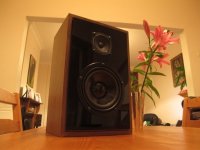 stella2.jpg63.1 KB · Views: 72
stella2.jpg63.1 KB · Views: 72 -
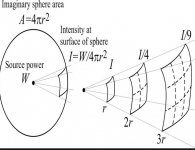 Spherical Waves.JPG40.7 KB · Views: 65
Spherical Waves.JPG40.7 KB · Views: 65 -
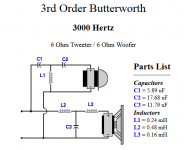 Third Order Theoretical values 3kHz.PNG18.6 KB · Views: 64
Third Order Theoretical values 3kHz.PNG18.6 KB · Views: 64
Last edited:
Eh, what? Got dizzy and fell a sleep halfway
Lol Sorry
I am just trying to explain something I've heard but find it hard to explain. Instead what I will say is nice and understandable, the idea of it instead as my theory can't be proven and I may be getting information wrong but the method definitely works and it needs it for best sound. The eq is used to alter the frequency's volume's distances, delays etc, so that our ears believe it is actually coming from a different location(illusion) than the source (speaker) but all the different frequency levels must be related so they appear to come from the same location as the altered location and give the same accoustics as it would in real life as if it were actually coming from same location, so they are phase coherent and it creates a location illusion that fixes the crosstalk interference and uses it instead as advantage and causes both ears to obtain the correct frequencys at the ear at the correct times, we only know how it arrives at the ear, not where it comes from. The way in which are ears pick up definitely use frequencys like a radar. Maybe all the drop in midrange frequency's volume actually does is to delay the sound compaired to the other frequenys and make it wrap around the listener more like bass and also being softer in amplitude. I believe that amplitude when any frequency is played at a lower volume it doesn't have so much bass, the peaks of the waves are shorter. I believe that the amplitude difference creates a frequency on another axis and we are trying to use this to our advantage by playing in a way that allows both ears to have the same response using the crosstalk and having waves come together to create the original waves, we were altering to use the crosstalk to fix the dual perspective of frequencys to come together to sound like original but from an illusion point of view it is perfect and will allow us to hear the sound like it is coming from our mind rather than speakers. All I'm trying to say is if we can fool our ears so it sounds as the same frequency to the ears, it all seems to come from the same location and also maybe the delay or lower levels can also interact with the sounds on the other ear. I have also heard an infinite sweet spot in mono. I could walk left or right, anywhere in the room and the sound came exactly from the middle. I think this is what I will try and acheive during any experimentations. I am currently looking for a good amplifier etc in which I'll hopefully be able to get a proper balance at the ears. All I'm going to say is I can assure you that there is a setting with the right equipment and patience that will blow your mind. Lets just say that are ears hear bass from around us in a rather large circle but we can not home in on it to the location with bass alone, the treble part of the sound will divide it very finely to a very small part of the bass, the midrange will do the same but less accurate and maybe it also gives us height too but when dividing it will be different depending on how high the speakers are compaired to our ears, it creates it own accoustic for our ears for direction, hence the same sound at source, the ears will accoustically divide the sound into either more bass or treble depending if it is higher than our ears or lower. Our ears are altering the sound, so by cutting the midrange and making it sound more like a high, as it is cut it will arrive at ears differently which will alter the location. Simple terms the ears change the character of the waves for it's own directional purpose but by making frequencys crosstalking sound a like, our ears pick up the same location but we still want to hear the original frequency at same volume. The gap between the two high frequencys is equivalent to the original frequency, we are literally just twisting the image into a straight line to our ears. It is very tough to grasp and set up but well worth it as it will give an out of this world illusion. The frequencys that been adjusted and sound uneven come together with other frequencys to sound even together and on both ears, walk to the left and right and the dual perspective will twist as our ears pick up different but the perspective will be the same. Remember it is the pattern of the sound we hear and reconise. It's hard to explain but if you listened, you would easily understand.
Even more simple explaination, flat playback destroys all the que's when the ears try to determine direction unless you are focused in the middle. The eq method when set right will give whole room as sweetspot and appear in your mind. It is kind of like mixing to create original frequency from more than one wave. How they arrive is how they sound. each interference and wave is part bass perspective and part treble of other perspective and they both crosstalk to create an accoustically correct response from the same distance. Thanks. Sorry it's long. I really wish people could understand and experiment. We can say it is personallized and set to our ears but many have never done this. It can not be done unless you have right equipment and you need to listen and maybe spend hours fiddling but if you can get it right and understand. The more love time and patentience you have for it, the more likely you are of acheiving mind blowing sound. Experiment and see if you can understand. I am really serious to how my music will sound. Nothing more amazing.
Speakers with a flat response sound exactly like that, harsh, shrill and lifeless. I don't know what it is, but it isn't a realistic or pleasing kind of sound.
What you are after, is a slowly falling frequency response. There are a few 'target curves' you can aim for with equalisation and a measurement mic, but otherwise trust your ears.
A lot of commercial speakers eg B&W have curves that look like rollercoasters but they still sound pretty good
Target Curves
What you are after, is a slowly falling frequency response. There are a few 'target curves' you can aim for with equalisation and a measurement mic, but otherwise trust your ears.
A lot of commercial speakers eg B&W have curves that look like rollercoasters but they still sound pretty good
Target Curves
^ It's called, stream of consciousness .
.
This book breaks the grammar rules...but works https://en.wikipedia.org/wiki/Angela's_Ashes
PS note the correct spelling grammar
This book breaks the grammar rules...but works https://en.wikipedia.org/wiki/Angela's_Ashes
PS note the correct spelling grammar
PS note the correct spelling grammar
LOL got me there Scott
- Status
- This old topic is closed. If you want to reopen this topic, contact a moderator using the "Report Post" button.
- Home
- Loudspeakers
- Multi-Way
- Why the emphasis on flat speaker response?